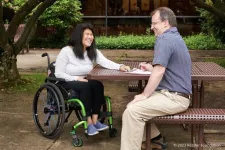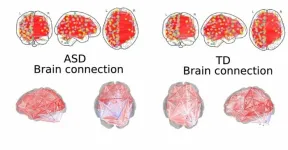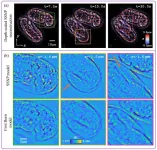(Press-News.org) New Cleveland Clinic research shows how mosquito-transmitted viruses – like Zika, West Nile, Yellow Fever and dengue viruses – hijack host cells to promote their own replication and infection. Published in Cell Host and Microbe, a recent study from the laboratory of Michaela Gack, Ph.D., Scientific Director of Cleveland Clinic’s Florida Research & Innovation Center, opens the door to developing new therapeutics for flaviviruses, a class of viruses for which either no or very limited treatments currently exist.
This is Dr. Gack’s first research study funded by a prestigious National Institutes of Health Pioneer Award, which she received in 2021. Part of the “High-Risk, High-Reward Program,” the Pioneer Award supports accelerating the pace of biomedical discoveries by funding exceptionally creative scientists with highly innovative research.
“Our findings bring us one step closer to understanding and treating currently untreatable mosquito-transmitted pathogens, which are an ever-increasing threat to global human populations,” says Dr. Gack. “This research was made possible by the NIH and Cleveland Clinic. Our commitment to studying viral pathogens and host enzymes in novel ways may ultimately help us develop new, effective treatments to prevent future threats to human health.”
Dr. Gack is a noted expert and core member of the Sheikha Fatima bint Mubarak Global Center for Pathogen & Human Health Research, which was founded with the goal of preventing and protecting against public health outbreaks before they start.
A hostile takeover by the virus
Viruses cannot survive on their own. While they contain their own genetic material, they don’t carry all the genes or factors they need to live and reproduce. That’s why viruses infect hosts – they hijack mammalian cells to turn them into virus-making factories.
To take control of the infected host cell, Zika virus, for example, hijacks several proteins inside the cell for its efficient replication. Humans have many enzymes that 'tag’ proteins with other molecules allowing them to function properly. Since Zika virus is missing certain molecules necessary for its reproduction, it has evolved to utilize a human enzyme called KAT5γ (an acetyltransferase) which helps the virus to amplify its RNA genome in viral replication complexes.
Treating the untreatable
The discovery of KAT5γ’s critical role in flavivirus replication is the key first step in beginning to design inhibitory molecules to stop viral replication and treat infection.
“Viruses mutate so much that drugging them directly might lose effectivity over time – this is what is known as antiviral drug resistance. Human proteins don’t change rapidly,” explains the study’s second author Cindy Chiang, Ph.D. “Targeting the host’s KAT5γ protein should be much more effective in the long term to treat these viruses.”
The study’s findings suggest that creating drugs targeting the human KAT5γ enzyme might help target not only Zika, but also several other mosquito-transmitted flaviviruses.
END
Cleveland Clinic researchers identify novel host-based target against multiple mosquito-transmitted viruses
Flaviviruses are responsible for widespread global diseases, including Zika, West Nile, Yellow Fever and Dengue
2023-08-15
ELSE PRESS RELEASES FROM THIS DATE:
New: Cutting-edge natural bioactive molecules effectively reduce cold symptoms
2023-08-15
New York, August 10, 2023 – Researchers at Applied Biological Laboratories Inc. discovered how natural bioactive molecules can effectively relieve cold and flu symptoms by protecting the mucosal barrier function and reducing inflammation during these infections. Together, they call these molecules, which include lysozyme and lactoferrin, the “Mucosal Immune Complex.”
The research, led by Nazlie Sadeghi-Latefi, PhD, highlights the importance of supporting mucosal barrier immunity to prevent and treat colds and flu. This work will be presented at the American Chemical Society Fall 2023 Meeting on August 15, 2023.
Mucosal ...
Benefits of electric stoves on health and environment in Ecuador
2023-08-15
One of the most popular strategies to increase energy efficiency and reduce pollution in homes — which are responsible for approximately 10 percent of greenhouse gas emissions — is the transitioning from gas to electric stoves. An international team of researchers investigated the health and environmental impacts of a program in Ecuador that put induction stoves in 750,000 households.
In the Aug. 15, 2023 online issue of the Proceedings of the National Academy of Sciences, researchers report that both greenhouse gas emissions ...
Novel hardware approach offers new quantum-computing paradigm
2023-08-15
LOS ALAMOS, N.M., Aug. 15, 2023 — A potentially game-changing theoretical approach to quantum computing hardware avoids much of the problematic complexity found in current quantum computers. The strategy implements an algorithm in natural quantum interactions to process a variety of real-world problems faster than classical computers or conventional gate-based quantum computers can.
“Our finding eliminates many challenging requirements for quantum hardware,” said Nikolai Sinitsyn, a theoretical physicist at Los Alamos National Laboratory. He is coauthor of a paper on the approach in the journal Physical Review A. “Natural systems, such as the electronic ...
New online course equips personal care assistants with essential knowledge for supporting individuals with spinal cord injury
2023-08-15
East Hanover, NJ – August 15, 2023 – "Understanding Spinal Cord Injury: A Course for Personal Care Assistants" a new interactive online course designed to enhance the training of personal care assistants (PCAs) for individuals with spinal cord injury, was presented today at the Paralyzed Veterans of America Healthcare (PVA) Summit + Expo at the Renaissance Orlando at SeaWorld Hotel in Orlando, FL, by Jeanne Zanca, MPT, PhD, FACRM, assistant director of the Center for Spinal Cord Injury Research at Kessler Foundation, and chair of the Foundation’s Institutional Review ...
Classic rock music can be recreated from recorded brain activity
2023-08-15
Researchers led by Ludovic Bellier at the University of California, Berkeley, US, demonstrate that recognizable versions of classic Pink Floyd rock music can be reconstructed from brain activity that was recorded while patients listened to the song. Published August 15th in the open access journal PLOS Biology, the study used nonlinear modeling to decode brain activity and reconstruct the song, “Another Brick in the Wall, Part 1”. Encoding models revealed a new cortical subregion in the temporal lobe that underlies rhythm perception, which could be exploited ...
Brain recordings capture musicality of speech — with help from Pink Floyd
2023-08-15
As the chords of Pink Floyd's “Another Brick in the Wall, Part 1,” filled the surgery suite, neuroscientists at Albany Medical Center diligently recorded the activity of electrodes placed on the brains of patients undergoing epilepsy surgery.
The goal? To capture the electrical activity of brain regions tuned to attributes of the music — tone, rhythm, harmony and words — to see if they could reconstruct what the patient was hearing.
More than a decade later, after detailed analysis of data from 29 such ...
Study proposes use of artificial intelligence to diagnose autism spectrum disorder
2023-08-15
Diagnosing autism spectrum disorder (ASD) is still a daunting challenge because of the degree of complexity involved, requiring highly specialized professionals. Autism is a multifactorial neurodevelopment disorder with widely varying symptoms. In the United States, about 1 in 36 children have been diagnosed with ASD, according to the Centers for Disease Control and Prevention (CDC), and yet there are no biochemical markers to identify it with precision. A quantitative diagnostic method is proposed by Brazilian researchers in an article published in ...
New algorithm captures complex 3D light scattering information from live specimens
2023-08-15
BOSTON - Researchers have developed a new algorithm for recovering the 3D refractive index distribution of biological samples that exhibit multiple types of light scattering. The algorithm helps optimize a new imaging approach called intensity diffraction tomography (IDT).
Jiabei Zhu from Boston University will present this research at the Optica Imaging Congress. The hybrid meeting will take place 14 – 17 August 2023 in Boston, Massachusetts.
“3D quantitative phase imaging (QPI) has superior features for various applications in the field of biomedical imaging. As a label-free technique, QPI ...
Advanced magnesium-based hydrogen storage materials and their applications
2023-08-15
As an energy carrier, hydrogen holds the prominent advantages of high gravimetric energy density, high abundance, and zero emission, yet its effective storage and transportation remain a bottleneck problem for the widespread applications of hydrogen energy. To address such an issue, different types of hydrogen storage materials are developed and carefully investigated in the past decades. Among them, magnesium hydride (MgH2) has been considered as one of the most promising hydrogen storage materials because of its high capacity, excellent reversibility, sufficient magnesium reserves, and low cost. However, the poor thermodynamic and kinetic properties ...
Decoding how molecules "talk" to each other to develop new nanotechnologies
2023-08-15
Two molecular languages at the origin of life have been successfully recreated and mathematically validated, thanks to pioneering work by Canadian scientists at Université de Montréal.
Published this week in the Journal of American Chemical Society, the breakthrough opens new doors for the development of nanotechnologies with applications ranging from biosensing, drug delivery and molecular imaging.
Living organisms are made up of billions of nanomachines and nanostructures that communicate to create higher-order entities able to do many essential things, such as moving, thinking, surviving and reproducing.
“The key to life’s emergence ...
LAST 30 PRESS RELEASES:
Modulating key interaction prevents virus from entering cells
Project explores barriers to NHS career progression facing international medical graduates
Jeonbuk National University researchers explore the impact of different seasonings on the flavor perception of Doenjang soup
Two Keck Medicine of USC Hospitals named Leapfrog Top Teaching Hospitals
World-first discovery uncovers how glioblastoma tumours dodge chemotherapy, potentially opening the door to new treatments
A fatal mix-up: How certain gut bacteria drive multiple sclerosis
New AI tool identifies not just genetic mutations, but the diseases they may cause
Deep-learning model predicts how fruit flies form, cell by cell
Combination pills for high blood pressure may simplify treatment, improve long-term health
Immune system keeps mucosal fungi in check
Neurons within the brain use simple rules to localize genetic messages
Electrodes created using light
Second-hand gift-giving is a well-deliberated decision
How human interaction drove evolution to make bears less aggressive
National Poll: Few parents offer teens guidance on healthy eating during holiday season
Cannabis derivatives could provide new ovarian cancer treatments
Raising strong yeast as a petroleum substitute
Clues to the origin of hot Jupiters hidden in their orbits
Canada’s reduced pledge to Global Fund will impact domestic health
1 in 4 children with major traumatic injuries not cared for in pediatric trauma centres
Duke and Duke-NUS’ joint cross-population research to uncover "East-West" differences in disease and care
Scientists to ‘spy’ on cancer- immune cell interactions using quantum technology breakthrough
Tech savvy users have most digital concerns
Making lighter work of calculating fluid and heat flow
Normalizing blood sugar can halve heart attack risk
Lowering blood sugar cuts heart attack risk in people with prediabetes
Study links genetic variants to risk of blinding eye disease in premature infants
Non-opioid ‘pain sponge’ therapy halts cartilage degeneration and relieves chronic pain
AI can pick up cultural values by mimicking how kids learn
China’s ecological redlines offer fast track to 30 x 30 global conservation goal
[Press-News.org] Cleveland Clinic researchers identify novel host-based target against multiple mosquito-transmitted virusesFlaviviruses are responsible for widespread global diseases, including Zika, West Nile, Yellow Fever and Dengue






